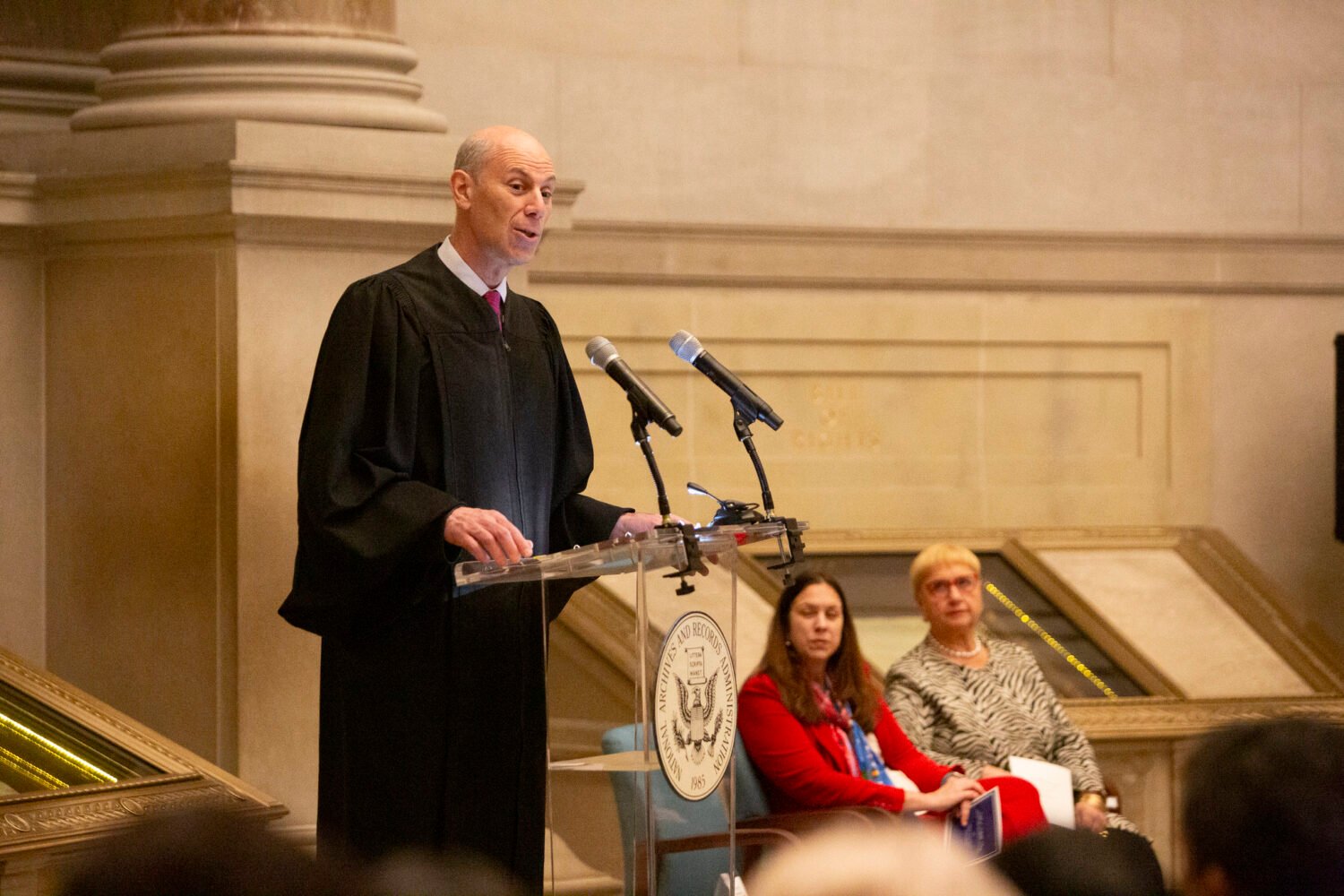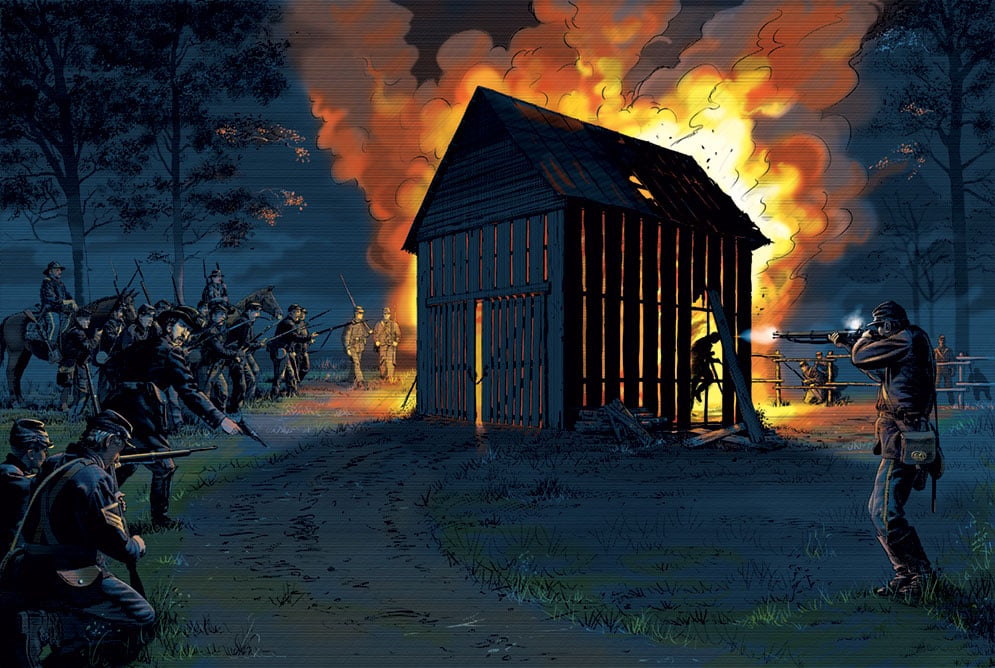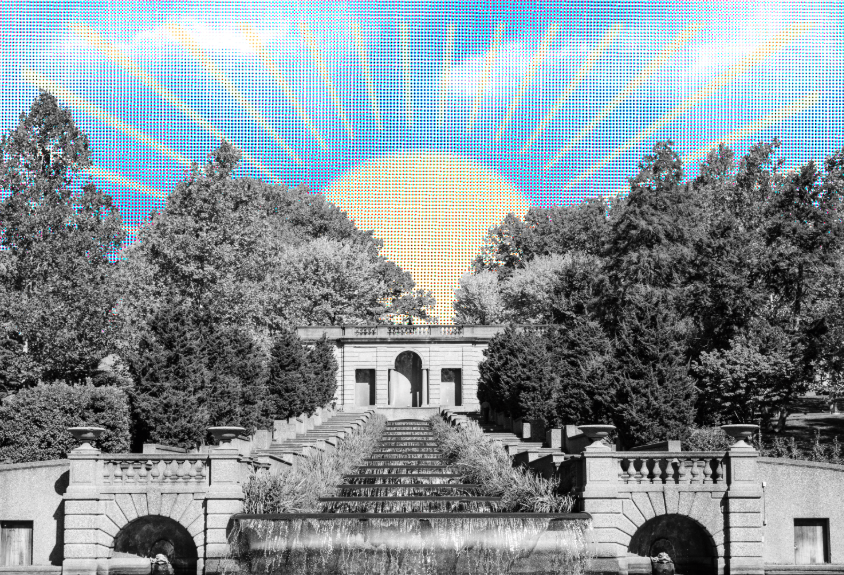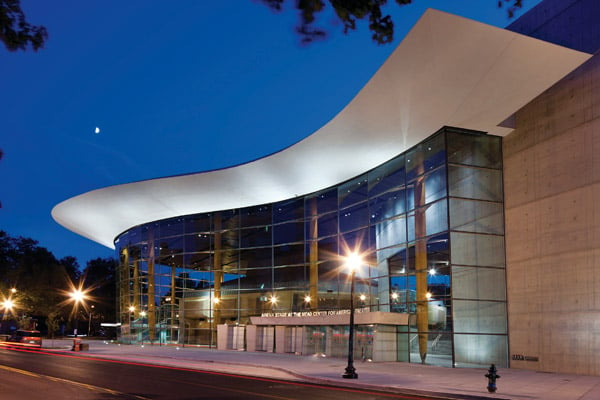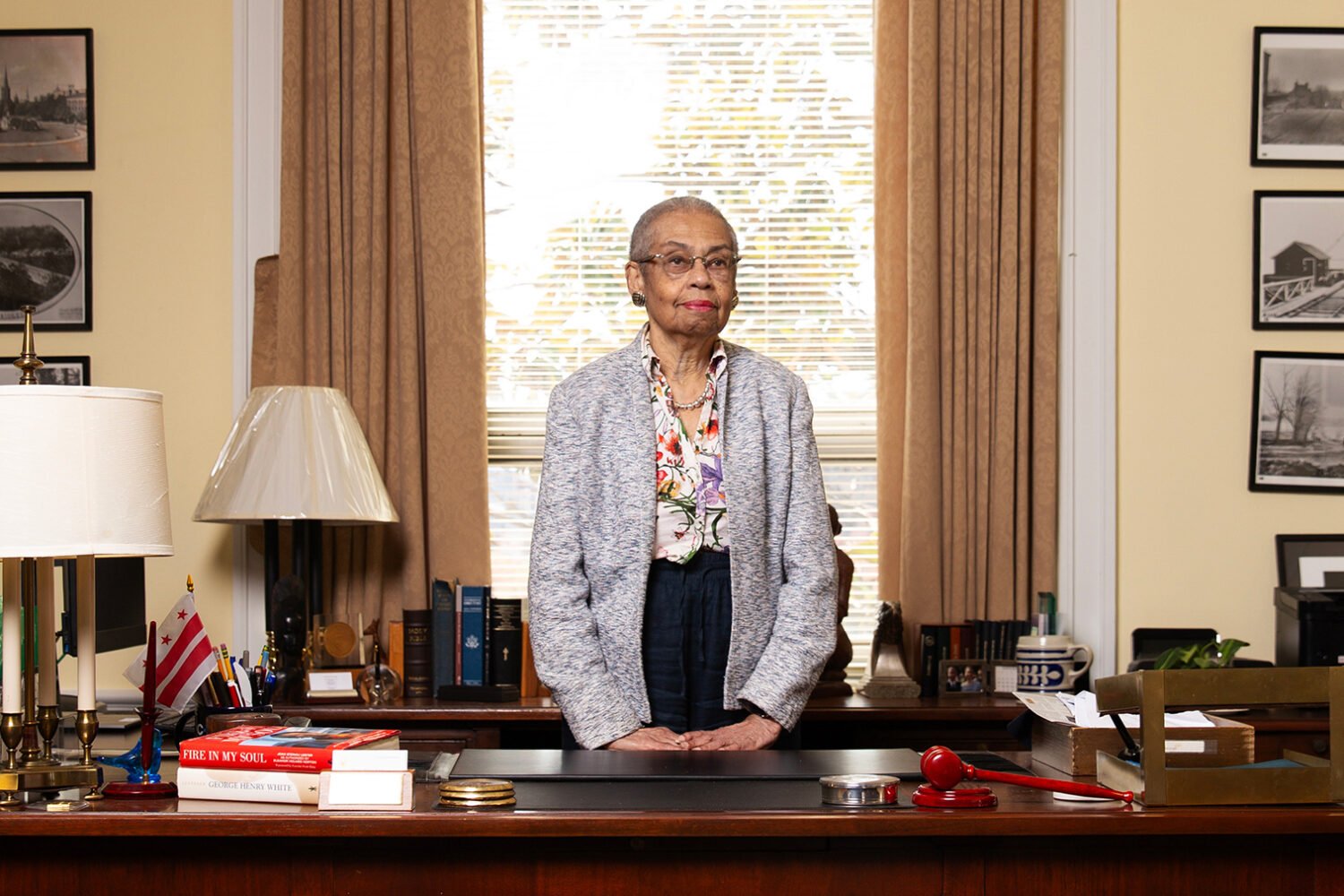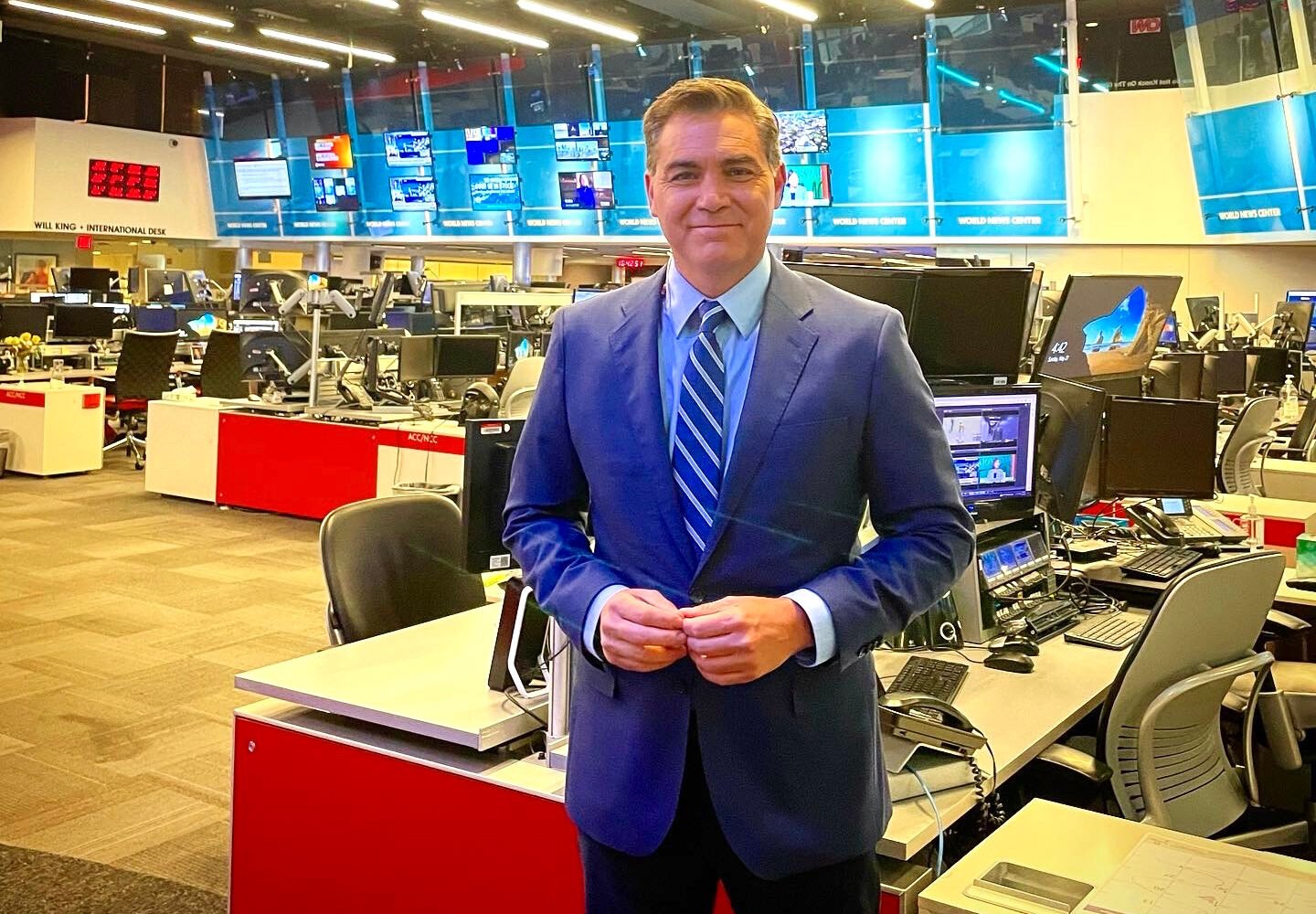Summing up the legacy of Dwight D. Eisenhower—the Army general from Kansas, World War II commander and Nazi vanquisher, 34th President of the United States, father of the modern highway system—is a tricky undertaking. Capturing his legacy in a bricks-and-mortar monument to last for all time—even more complicated.
But shorthanding the planning process for the monument? That’s fairly simple. “Winning World War II was easier ” is how a former federal official sums it up.
Back in 1999, a bipartisan pair of well-meaning senators got legislation passed to fund a memorial to Ike. The marching orders were straightforward: commemorate the victorious general and President of peace and prosperity on a piece of well-placed parkland.
At least the mandate seemed straightforward. As it turned out, the act of honoring a leader whose name is practically synonymous with leafy-green niceness hasn’t been so nice.
Fifteen years in, the Eisenhower Memorial Commission has little to show for the $40 million of public money it has spent to secure land, hire star architect Frank Gehry, and, mostly, try to fend off a war between all the muckety-mucks invested in the project.
Eisenhower’s heirs are irate at Gehry, who has had to defend his design from accusations that it evokes both Nazi concentration camps and 9/11. A local gadfly has taken to dismissing it as “a shrinky-dink tikey-Ikey” design. And a millionaire architecture buff from Chicago has bankrolled a K Street lobbying campaign to get the whole thing scrapped.
At one point, there were fears that the artist immortalizing Ike would be one whose portfolio includes sculptures of naked boys. That was a big turnoff for House Republicans, who paved the way for Congress to pull the plug on the memorial’s funding this past January.
To some, the debacle is a classic example of government waste, an inappropriate use of taxpayer dollars at a time of sequestration. To others, the problem is a matter of taste: The Gehry design is either too modern or too grand.
Perhaps more than anything, the clash is an allegory about coming to terms with mortality, for the act of honoring Ike—who died in 1969—is also a way for many of those involved to leave their own imprint on history. Rocco Siciliano, chairman of the Eisenhower commission and a former aide to Ike—who sees the memorial as a last hurrah for his “greatest generation” as much as it is a tribute to his old boss—is in his nineties. Gehry, who is arguably the most influential architect in the US yet hasn’t designed a single building in the nation’s capital, is 85. Some of the biggest champions of erecting a monument (if not necessarily the one currently on paper) have already died.
The monument was originally scheduled to open on Memorial Day in 2015, the 70th anniversary of World War II’s end. Instead, it’s dying a slow death. And the men who want it most are running out of time to save it.
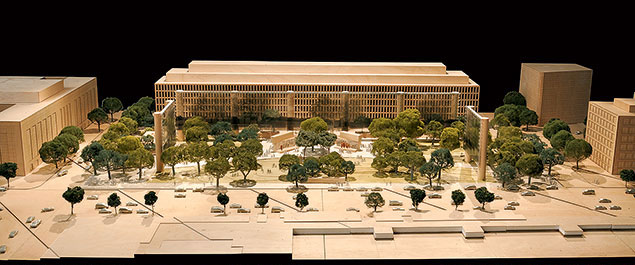
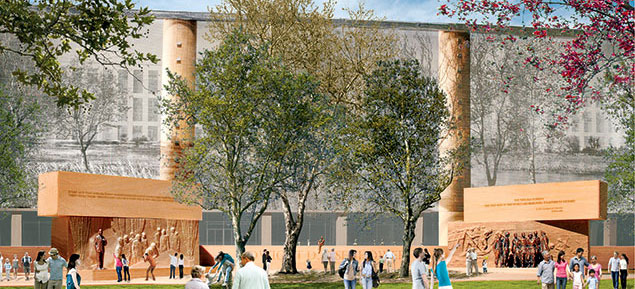
• • •
Siciliano was one of the first to envision the memorial. The Georgetown Law graduate served in Eisenhower’s White House from 1957 to 1959 and decades later became head of the Eisenhower Institute. In 1999, before stepping down from the think tank, he worked with two fellow World War II veterans, Republican senator Ted Stevens and Democratic senator Daniel Inouye, to write the bill for the monument and establish the 12-member commission.
Early on, there was a shared camaraderie among the Eisenhower family and the board. Eight members of Congress sat on it, along with a lawyer, a flack, and Ike’s only grandson, Dwight David Eisenhower II, the historian and author for whom Camp David is named. Siciliano, who lives in Beverly Hills and flies in for board meetings, was named chairman.
Picking a suitable piece of federal real estate from 26 possibilities took several years, ending with the selection of a four-acre parcel next to the Mall and wedged between the National Air and Space Museum and the Department of Education—both totems of Ike’s era.
The next step, choosing one designer from the hundreds who might want the assignment, promised to be a bigger task. “Eisenhower had a traditional element to himself, but at the same time underneath this he was always probing the elements of change in the modernization of the world,” says Carl Reddel, the commission’s executive director. “It was quite magical, the way in which he would do this.” The challenge for the artist was to fuse those opposing forces visually.
From the start, the commission was thinking big. At one meeting, Inouye speculated that the memorial could become the most visited in Washington. Stevens announced that an “out-of-the-box” design was only fitting for a man who “saved the world.”
Siciliano, a retired financial-services executive, had someone in mind: Gehry, with whom he is friendly out west. The architect lives in Santa Monica, and the two had met through Siciliano’s late wife, an artist. The men also shared ties to LA’s arts community. Siciliano was on the board of the Los Angeles Philharmonic; Gehry designed its Walt Disney Concert Hall, a striking, curvy structure that epitomizes his daring and inventive forms.
Gehry has a small, dated footprint in Washington’s environs. He designed Merriweather Post Pavilion in the 1960s and the Rouse Company headquarters in the ’70s, both in Columbia. But much as he would have liked to, he hasn’t ever completed a job in the District. His absence in the capital isn’t for lack of trying. A stunning new wing he worked up for the Corcoran Gallery of Art got scrapped over funding at the eleventh hour in 2005.
Siciliano dropped Gehry’s name at two early commission meetings. The second time, in 2006, Susan Eisenhower, one of Ike’s granddaughters, asked whether “the design vocabulary would be modern or traditional,” according to the commission’s records. A staffer called the question “premature.” Siciliano assured her the result would be “high-quality,” before mentioning that Gehry was interested in the project.
By then, the first signs of strife were already visible.
Though she wasn’t an official member of the commission, Susan—a longtime Washingtonian who has known Siciliano for years—was welcomed into the fold initially. Like Siciliano, she cared deeply about her grandfather’s legacy. But she and his former aide didn’t always agree.
Right after the commission formed, Susan and her siblings wanted it to consider a “living memorial”—something like DC’s Woodrow Wilson Center—not a monument. After all, the Eisenhower Executive Office Building, near the White House, already pays tribute to the President. Siciliano was skeptical of a living memorial’s costs, but the idea intrigued both Stevens and Inouye, so Siciliano agreed to look into it.
That was as far as the living memorial ever got. The Eisenhower Institute produced a study with more than $200,000 of the commission’s funds, but at a 2007 meeting Siciliano reported that the Institute and other organizations tied to Eisenhower considered the proposal redundant with their own work. The living memorial died. For Susan Eisenhower, the memory of defeat is still fresh. “There was a real sense of disappointment,” she says.
• • •
After reviewing more than 40 proposals, the commission voted in the spring of 2009 to hire Gehry. He was actually David Eisenhower’s second choice. But David went along with the majority. As Dan Feil, the commission’s staff architect, says, “I remember David came up to me after the vote was done. He said, ‘You know, I think the family should be really honored about having Gehry design this. It’s a very fine choice.’ ”
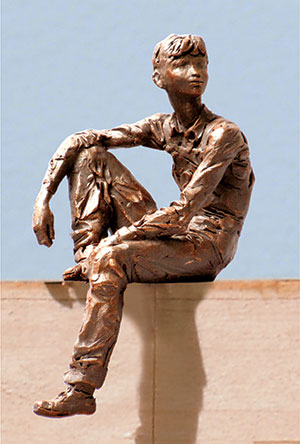
The proposals at that point weren’t full-scale models, merely preliminary concepts outlining an overall vision. Gehry spent the next year fleshing out his idea. In the spring of 2010, he traveled to Washington to unveil the dramatic result: three giant stainless-steel “tapestries” woven with scenes from Eisenhower’s life, hung from 11 80-foot-tall, 11-foot-wide columns and flanked by a series of bas-reliefs showing Ike as general and President. The ensemble would frame a landscaped plaza the way a set of open theater curtains does a stage.
Kansas senator Pat Roberts called the design “wonderful,” according to minutes from the commission meeting with Gehry. PR executive Alfred Geduldig summed it up as “magnificent,” and Iowa congressman Leonard Boswell said he couldn’t “compliment Mr. Gehry enough.” David Eisenhower called the design “striking” and praised the columns for symbolizing “the upward emergence of the United States to world power in the mid-twentieth century.” David and Susan’s sister Anne Eisenhower, an interior designer in New York, said it looked “wonderful.”
That was the last time Gehry would get such an outpouring of support.
• • •
Justin Shubow was the first to strike. A former editor of the neoconservative Commentary magazine, he leads the National Civic Art Society (NCAS), a tiny nonprofit with an anti-modernist agenda.
After Gehry’s design was announced, Shubow began fighting it. He started the website EisenhowerMemorial.net to bash the design, requested reams of documents through the Freedom of Information Act, and railed against what he believed was a rigged process set up to coronate Gehry long before any proposals were solicited. With its shoestring budget (the NCAS takes in less than $50,000 a year), Shubow’s group ran its own design competition and opened it up to anyone, not just architects. In the spring of 2011, the NCAS chose a “winner” from 32 submissions: a structure that calls to mind the Arc de Triomphe.
Shubow basically became a pest to the commission, copiously recording public presentations and parsing his opposition’s words for sound bites that might seem damning. In the fall of 2011, Gehry delivered a doozy.
That October, the architect appeared twice in Washington to explain the design in more depth. He brought along Robert Wilson, a playwright and avant-garde theater director he had tapped to help create the scene. Gehry hadn’t included any statue of Ike in his earlier models, but now, after more reflection and at the Eisenhowers’ urging, Gehry realized Ike should be present. At the heart of the vast, sweeping scene in his new models, the architect placed a lone statue of Eisenhower, depicting him not as a commanding general or a forward-thinking President but as a young boy.
Gehry and Wilson were struck by the leader’s attachment to his hometown—Abilene, Kansas—and fixated on a speech Eisenhower gave at his homecoming there after the war: “Because no man is really a man who has lost out of himself all of the boy,” Ike said. “I want to speak first of the dreams of a barefoot boy.”
“He talked about it all the time,” Gehry explained. “It had a resonance for this man’s core and essence, his humility, his sense of where he came from, the heartland of America.”
At that point, the “barefoot boy” sculpture, as it came to be called, wasn’t fully conceived—it wasn’t clear what material it might be cast from or who would do it, but Gehry did mention that he had sought advice from a contemporary sculptor named Charles Ray.
There was already some behind-the-scenes tittering about the involvement of Wilson, whom some viewed as an edgy influence. Now Gehry’s association with Ray, who had his own edginess, was about to become toxic.
In 2007, the Los Angeles Times counted Ray among the most important American artists of the previous 20 years. But an untrained (or anti-modernist) eye scrolling quickly through his website might conclude that some of his art veers toward the racy. There are sculptures of naked adults with lifelike genitalia, an orgiastic ensemble of naked young men, and “Boy With Frog,” a larger-than-life nude youth holding a helpless amphibian by one leg.
In Shubow’s mind, Gehry’s memorial amounted to “sentimental kitsch,” a “Happy McMonument,” and, as he put it in a 153-page chronicle of his many problems with the memorial, “a Leviathan structure swallowing a small-fry Eisenhower.”
The coup de grâce: “The design of the boy Eisenhower statue is being advised by Charles Ray, an artist whose work sexualizes children and is obscene.” (This claim was removed from a later edition of the report.)
• • •
The Eisenhower family admitted their distaste for the design on Gehry’s second day of speeches in Washington. Susan, Anne, and their sister, Mary Jean, issued a statement asking for the approval process to stop.
They didn’t get their wish. Two months later, David Eisenhower suddenly resigned from the commission, sparking rumors of dissent in the family.
To quell the chatter, Ike’s son John Eisenhower wrote daughters Anne and Susan to say he was “totally behind” their efforts to have the Gehry design rethought. The letter was then made public.
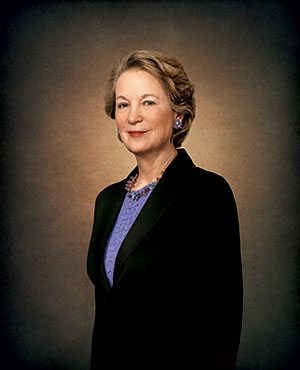
Susan and Anne say they were never wowed by Gehry’s design. (Anne’s earlier description of it as “wonderful” came, she says, after being able to look at it for only a few minutes.) The new barefoot-boy theme exacerbated their displeasure.
The family found a friendly audience on Capitol Hill, where a growing number of Congress members were also upset about the design. At a tense hearing held by Republican Rob Bishop, chair of a House subcommittee overseeing public lands, Susan flagged the more provocative complaints she said her family had received: that the massive columns were like “missile silos,” that the tapestries were reminiscent of the Iron Curtain, and that its chain links called to mind fences around Nazi concentration camps. Again, she asked for the project to be shelved.
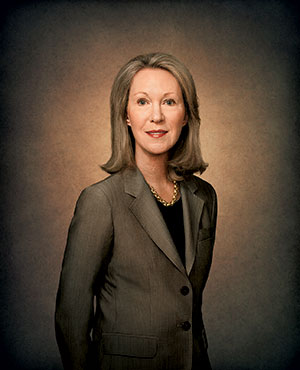
Reddel, the commission’s director, brought up the touchiest subject, the sculpture. “It has never been a barefoot boy,” he insisted at the hearing. “The designer’s vision is that a young Eisenhower will be looking out at what he is to become.” Reddel turned his closing remarks directly to Susan and her siblings: “We have benefited from the Eisenhower family participation in our 15 commission meetings over the years,” he said, “especially from David Eisenhower.”
The dig at Susan speaks to her power. Informed by her DNA and by her decades-long career as president of the Eisenhower Group, a politics-and-business consultancy, she maneuvers comfortably in the capital and makes for a formidable opponent.
By May of 2012, the commissioners were exasperated. They didn’t want to toss out Gehry or the design. But they couldn’t assuage the family. Senator Roberts, a member of the commission who had been dispatched to try to smooth relations with the Eisenhowers, conceded at a meeting that month that he wasn’t successful. The minutes of the meeting aren’t very charitable: “Senator Roberts observed that one really gets to know people in situations such as this and that he feels he has gotten to know the Eisenhower family for twenty-five years within the past three months.”
• • •
Frank Gehry reworked every element of the design. The tapestries took on pastoral scenes. Eisenhower’s military career and his time in the Oval Office came to life through statues on the plaza and quotes from speeches etched into the bas-reliefs (which were in, then out, then back in again). The barefoot boy, standing (and then sitting) on a ledge at the back of the scene, was recast as “a young man.”
“One thing that gets overlooked—and the critics prefer to overlook it—is there have been a huge number of changes in response to concerns,” says Paul Goldberger, former architecture critic for the New Yorker. “Just not the changes they want.” Gehry is remarkable for his willingness to work with clients, says Goldberger, who is writing a biography of the architect. “It has hardly been ‘it’s my way or the highway’ from Gehry.”
But as the commission plowed ahead, the opposition gained momentum.
In mid-2012, Richard Driehaus—a 71-year-old Chicago businessman and classical architecture enthusiast who writes checks to Shubow’s group—launched a shadow campaign against the memorial. Driehaus hired the lobbying firm Potomac Strategic as well as ASGK, the public-affairs company founded by fellow Chicagoan David Axelrod, to stir up attacks on the plans under a campaign called Right by Ike. (Driehaus declined to say what he has spent on the efforts.)
The continuing brouhaha so rattled Republican congressman Darrell Issa—who chairs the House Oversight Committee and sits on one of the two government-funded panels that must approve the monument—that he paid a visit to Gehry in Santa Monica for a firsthand account. Issa was upset that the family was being ignored, and he didn’t like the design.
In late summer that year, Siciliano penned a defensive letter to Senator Inouye, who after 13 years was also still on the commission and trying to broker peace with the family. “I know that tastes and judgments will always vary—no matter the subject—whenever a decision by more than one person is sought,” Siciliano wrote. “I am one person who feels competent to say that he believes President Eisenhower would be most pleased as to what the present Commissioners have unanimously accepted.”
Siciliano’s bluster inflamed John Eisenhower. “I am the first to admit that this memorial should be designed for the benefit of the people, not our family,” he wrote to Inouye. “However, I am astonished by Rocco Siciliano’s claim that his service in the White House gives him an unusual perspective on how my father would view this design. Besides being Ike’s son, I served as an aide for a while just after the War, worked in the West Wing during the last years of the Eisenhower presidency, and later, at Gettysburg, assisted him in writing his presidential memoirs. And yet I would not make a claim like Mr. Siciliano’s.”
• • •
“After the tumult” of 2012, Susan Eisenhower says, “a member of Congress called me and said, ‘I don’t like the way you’re being treated, and I’m going to do something about it.’ ”
In early 2013, Congressman Rob Bishop introduced the Dwight D. Eisenhower Memorial Completion Act, calling for a hold on the memorial’s federal funding and a new design. There were more hearings, more meetings, more op-eds flung. The two government-funded panels that have to sign off on the design kept kicking it down the road.
At an emotional meeting of the commission last June, the most recent one to date, Idaho congressman Mike Simpson read aloud a letter from the Eisenhowers warning that if the commission forged on without their support, it would be difficult to raise “crucial” private-sector money.
According to the minutes of the meeting, Siciliano was frustrated but resigned to his differences with the Eisenhowers. He “observed that few people can know the extent to which the Commission has worked with the Eisenhower family, and that, while the family deserves to be heard, the family does not have to be obeyed.”
• • •
Senator Inouye died in December 2012. A year later, John Eisenhower died at the age of 91.
The big elements of Gehry’s concept—the tapestries and the columns—remained.
They’re “a deal breaker” in Susan Eisenhower’s view. On paper, the memorial is still “a theme park,” she says. Now, if Gehry were to remove the tapestries, “then do we have a problem with the design of the interior of the memorial? No.”
But to take the tapestries out of the design is to take Frank Gehry out of it, too. “There ain’t much left of him” at that point, a confidant of Gehry’s says. “He’d feel it was so eviscerated, there’s not much point in going on.”
Whether the architect has the desire to continue is beginning to seem like a real question. He hasn’t come to Washington for a public hearing in 11 months. The oversight panel that must sign off on the technical aspects of the $142-million design again delayed making a final decision at its most recent meeting, on April 3. Moreover, Congress yanked the commission’s budget this year—making it increasingly unlikely the memorial will be shovel-ready anytime soon, if ever.
The simple fact of memorials in Washington is that none has ever avoided controversy, even those we’ve come to love. The last presidential memorial to take root, the FDR, dedicated in 1997, faced rancor from the Roosevelt family at the outset and churned through three architects by the end. It took 42 years.
The next one won’t be easy, either. Thirteen years ago, Congress signed off on a monument to President John Adams; his wife, Abigail; their son, President John Quincy Adams; his wife, Louisa, and their offspring. Considering how many legacies must be taken into account, this Adams Family memorial, as it were, may be the most ambitious presidential monument yet. “It’s going to be messy,” a congressional staffer says. “There’s already a dispute between the Adams ancestors and the National Park Service.”
This article appears in the May 2014 issue of Washingtonian.



